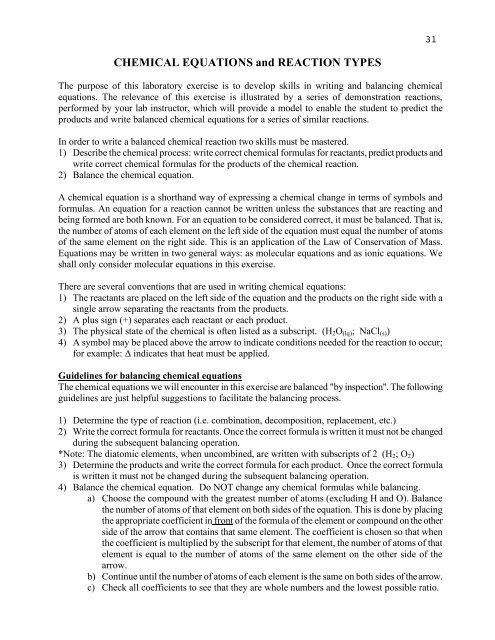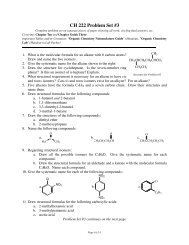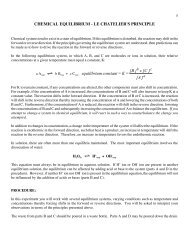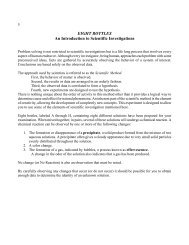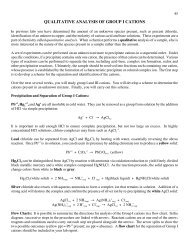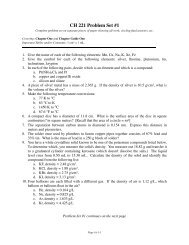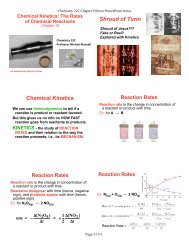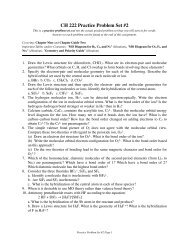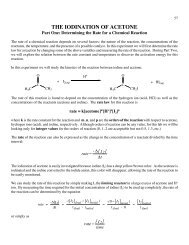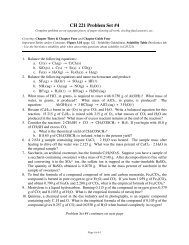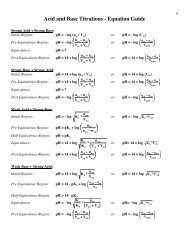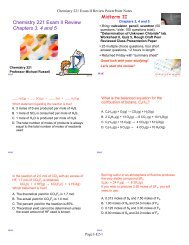CHEMICAL EQUATIONS and REACTION TYPES
CHEMICAL EQUATIONS and REACTION TYPES
CHEMICAL EQUATIONS and REACTION TYPES
- No tags were found...
You also want an ePaper? Increase the reach of your titles
YUMPU automatically turns print PDFs into web optimized ePapers that Google loves.
31<strong>CHEMICAL</strong> <strong>EQUATIONS</strong> <strong>and</strong> <strong>REACTION</strong> <strong>TYPES</strong>The purpose of this laboratory exercise is to develop skills in writing <strong>and</strong> balancing chemicalequations. The relevance of this exercise is illustrated by a series of demonstration reactions,performed by your lab instructor, which will provide a model to enable the student to predict theproducts <strong>and</strong> write balanced chemical equations for a series of similar reactions.In order to write a balanced chemical reaction two skills must be mastered.1) Describe the chemical process: write correct chemical formulas for reactants, predict products <strong>and</strong>write correct chemical formulas for the products of the chemical reaction.2) Balance the chemical equation.A chemical equation is a shorth<strong>and</strong> way of expressing a chemical change in terms of symbols <strong>and</strong>formulas. An equation for a reaction cannot be written unless the substances that are reacting <strong>and</strong>being formed are both known. For an equation to be considered correct, it must be balanced. That is,the number of atoms of each element on the left side of the equation must equal the number of atomsof the same element on the right side. This is an application of the Law of Conservation of Mass.Equations may be written in two general ways: as molecular equations <strong>and</strong> as ionic equations. Weshall only consider molecular equations in this exercise.There are several conventions that are used in writing chemical equations:1) The reactants are placed on the left side of the equation <strong>and</strong> the products on the right side with asingle arrow separating the reactants from the products.2) A plus sign (+) separates each reactant or each product.3) The physical state of the chemical is often listed as a subscript. (H 2 O (lq) ; NaCl (s) )4) A symbol may be placed above the arrow to indicate conditions needed for the reaction to occur;for example: Δ indicates that heat must be applied.Guidelines for balancing chemical equationsThe chemical equations we will encounter in this exercise are balanced "by inspection". The followingguidelines are just helpful suggestions to facilitate the balancing process.1) Determine the type of reaction (i.e. combination, decomposition, replacement, etc.)2) Write the correct formula for reactants. Once the correct formula is written it must not be changedduring the subsequent balancing operation.*Note: The diatomic elements, when uncombined, are written with subscripts of 2 (H 2 ; O 2 )3) Determine the products <strong>and</strong> write the correct formula for each product. Once the correct formulais written it must not be changed during the subsequent balancing operation.4) Balance the chemical equation. Do NOT change any chemical formulas while balancing.a) Choose the compound with the greatest number of atoms (excluding H <strong>and</strong> O). Balancethe number of atoms of that element on both sides of the equation. This is done by placingthe appropriate coefficient in front of the formula of the element or compound on the otherside of the arrow that contains that same element. The coefficient is chosen so that whenthe coefficient is multiplied by the subscript for that element, the number of atoms of thatelement is equal to the number of atoms of the same element on the other side of thearrow.b) Continue until the number of atoms of each element is the same on both sides of the arrow.c) Check all coefficients to see that they are whole numbers <strong>and</strong> the lowest possible ratio.
32The following example illustrates these guidelines.Ca(OH) 2 + H 3 PO 4 → Ca 3 (PO 4 ) 2 + H 2 OStart by balancing the calcium atoms in calcium phosphate first, since calcium phosphate contains themost atoms of an element other than H or O. This requires a coefficient of 3 to be placed in front ofCa(OH) 2 on the other side of the arrow.3 Ca(OH) 2 + H 3 PO 4 → Ca 3 (PO 4 ) 2 + H 2 ONext balance the phosphate (if a polyatomic is found on both sides of the equation, it is easier tobalance for the polyatomic than as each type of element) by putting a 2 in front of H 3 PO 4 .3 Ca(OH) 2 + 2 H 3 PO 4 → Ca 3 (PO 4 ) 2 + H 2 OThe hydrogen atoms now total 12 on the left side, 6 from the 3 Ca(OH) 2 "molecules" <strong>and</strong> 6 from 2H 3 PO 4 molecules. Therefore, place a 6 in front of the formula for water <strong>and</strong> the equation will bebalanced.3 Ca(OH) 2 + 2 H 3 PO 4 → Ca 3 (PO 4 ) 2 + 6H 2 OAll coefficients are whole numbers <strong>and</strong> the lowest possible ratio.Categories of Chemical Reactions:Most chemical reactions can be grouped into one of four categories:1.) Combination reactions A + B → AB2.) Decomposition reactions AB → A + B3.) Single replacement reactions A + BC → AC + B(Metal replace metals; non-metals replace non-metals.)4.) Double displacement reactions AB + CD → AD + CBa) Precipitation (solid forms)b) Neutralization (water is formed) [also called acid/base]Knowledge of the kind of reaction is useful in predicting the products in a particular reaction. Yourinstructor will demonstrate several reactions of each category, predicting the products, writing <strong>and</strong>balancing the chemical equation in each case. Using these as models, you will write <strong>and</strong> balancechemical equations of similar reactions.
33<strong>CHEMICAL</strong> <strong>EQUATIONS</strong>NAME:Write balanced equations. Your instructor will demonstrate the first two equations in each category.A. COMBINATION:1) (demo) The reaction of iron with oxygen to yield iron (III) oxide.2) (demo) Magnesium metal burning in air.3) The reaction of sodium metal with chlorine gas.4) The reaction of calcium with fluorine gas.5) The reaction of ammonia (NH 3 ) with hydrogen chloride to yield ammonium chloride.B. DECOMPOSITION1) (demo) The decomposition of nitrogen triiodide into its elements.2) (demo) The decomposition of ammonium dichromate, (NH 4 ) 2 Cr 2 O 7, into nitrogen, water, <strong>and</strong> chromium (III)oxide.3) The decomposition of potassium chlorate to potassium chloride <strong>and</strong> oxygen.
344) The thermal decomposition of ammonium carbonate into ammonia, carbon dioxide <strong>and</strong> water5) The decomposition of lead (IV) oxide to the elements.C. SINGLE REPLACEMENT1) The reaction of a solution of silver nitrate with copper metal. (demo)2) The reaction of sodium iodide <strong>and</strong> bromine. (demo)3) Zinc metal with sulfuric acid. (Look up the formula of sulfuric acid in your lecture text.)4) Chlorine with aqueous sodium bromide.5) Aluminum metal with aqueous copper (II) sulfate.
35D. DOUBLE DISPLACEMENT1) The reaction of aqueous solution of calcium chloride with ammonium carbonate. (demo)2) The action of vinegar (dilute acetic acid) on sodium bicarbonate. (demo)3) The reaction of hydrogen sulfide on a solution of lead (II) nitrate.4) The reaction of solutions of sodium chloride with silver nitrate.5) The reaction of magnesium chloride with sulfuric acid.
36POST LAB QUESTIONS:Write balanced chemical equations <strong>and</strong> classify.1. Calcium reacts with chlorine2. Sodium chloride is mixed with lead (II) nitrate3. Sodium reacts with zinc sulfate4. Diphosphorous pentoxide breaks down into its elements.5. Metallic aluminum reacts with nickel (II) nitrate.


